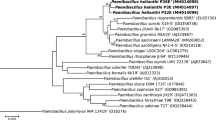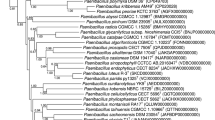Abstract
Twenty-three nitrogen-fixing bacteria were isolated from surface-sterilized stems and roots of wild rice Oryza rufipogon. Four clusters were defined among these bacteria by SDS-PAGE protein patterns and further confirmed by IS-PCR finger-printing analysis. Phylogenetic analysis of 16S rRNA gene sequences showed that the representative strains LS 8 and LS 18 of cluster II formed a monophyletic group sharing 94.0–97.3% similarities with defined enterobacterial species within the genera Salmonella, Citrobacter, Pantoea, Klebsiella, and Enterobacter. DNA–DNA hybridization, physiological, biochemical tests, and cell morphology also revealed that these strains could be differentiated from the related enterobacterial species. Based upon these results, we propose Phytobacter diazotrophicus gen. nov., sp. nov. to the bacterial group represented by strains LS 8 and LS 18. The type strain is LS 8T (=DSM 17806T = LMG 23328T = CGMCC 1.5339T). The DNA G+C content of strain LS 8T is 58.6 ± 0.5 mol%.



Similar content being viewed by others
References
Adhikari TB, Mew TW, Leach JE (1999) Genotypic and pathotypic diversity in Xanthomonas oryzae pv. oryzae in Nepal. Phytopathology 89:687–694
Asis CA, Adachi K (2004) Isolation of endophytic diazotroph Pantoea agglomerans and nondiazotroph Enterobacter asburiae from sweetpotato stem in Japan. Lett Appl Microbiol 38:19–23
Ausubel FM, Brent R, Kingston RE, Moore DD, Seidman JG, Smith JA, Struhl K (1987) Current protocols in molecular biology. John Wiley & Sons, New York
Baldani VLD, Doebereiner J (1980) Host-plant specificity in the infection of cereals with Azospirillum spp. Soil Biol Biochem 12:433–439
Baldani JI, Caruso L, Baldani VLD, Goi SR, Döbereiner J (1997) Recent advances in BNF with non-legume plants. Soil Biol Biochem 29:911–922
Baldani JI, Reis VM, Baldani VLD, Döbereiner J (2002) A brief story of nitrogen fixation in sugarcane – reasons for success in Brazil. Funct Plant Biol 29:417–423
Bardiya N, Bae JH (2004) Role of Citrobacter amalonaticus and Citrobacter farmeri in dissimilatory perchlorate reduction. J Basic Microbiol 44:88–97
Boddey RM, Urquiaga S, Alves BR, Reis V (2003) Endophytic nitrogen fixation in sugarcane: present knowledge and future applications. Plant Soil 252:139–149
Brenner DJ, Grimont PA, Steigerwalt AG, Fanning GR, Ageron E, Riddle CF (1993) Classification of citrobacteria by DNA hybridization: designation of Citrobacter farmeri sp. nov., Citrobacter youngae sp. nov., Citrobacter braakii sp. nov., Citrobacter werkmanii sp. nov., Citrobacter sedlakii sp. nov., and three unnamed Citrobacter genomospecies. Int J Syst Bacteriol 43:645–658
Brenner DJ, O’hara CM, Grimont PA, Janda JM, Falsen E, Aldova E, Ageron E, Schindler J, Abbott SL, Steigerwalt AG (1999) Biochemical identification of Citrobacter species defined by DNA hybridization and description of Citrobacter gillenii sp. nov. (formerly Citrobacter genomospecies 10) and Citrobacter murliniae sp. nov. (formerly Citrobacter genomospecies 11). J Clin Microbiol 37:2619–2624
Bruce RA, Achenbach LA, Coates JD (1999) Reduction of (per)chlorate by a novel organism isolated from paper mill waste. Environ Microbiol 1:319–329
Coates JD, Michaelidou U, Bruce RA, O’Connor SM, Crespi JN, Achenbach LA (1999) Ubiquity and diversity of dissimilatory (per)chlorate-reducing bacteria. Appl Environ Microbiol 65:5234–5241
Cole RM, Popkin TJ (1981) Electron microscopy. In: Gerhardt P et al (eds) Manual of methods for general bacteriology. American Society for Microbiology, Washington, DC, pp 34–51
de la Torre E, Tello M, Mateo EM, Torre E (2005) Use of biochemical kinetic data to determine strain relatedness among Salmonella enterica subsp. enterica isolates. J Clin Microbiol 43:5419–5424
De Ley J, Cattoir H, Reynaerts A (1970) The quantitative measurement of DNA hybridization from renaturation rates. Eur J Biochem 12:133–142
Eckert B, Weber OB, Kirchhof G, Halbritter A, Stoffels M, Hartmann A (2001) Azospirillum doebereinerae sp. nov., a nitrogen-fixing bacterium associated with the C4-grass Miscanthus. Int J Syst Evol Microbiol 51:17–26
Elbeltagy A, Nishioka K, Sato T, Suzuki H, Ye B, Hamada T, Isawa T, Mitsui H, Minamisawa K (2001) Endophytic colonization and in planta nitrogen fixation by a Herbaspirillum sp. isolated from wild rice species. Appl Environ Microbiol 67:5285–5293
Engelhard M, Hurek T, Reinhold-Hurek B (2000) Preferential occurrence of diazotrophic endophytes, Azoarcus spp., in wild rice species and land races of Oryza sativa in comparison with modern races. Environ Microbiol 2:131–141
Felsenstein J (1993) Phylip: Phylogeny Interference Package. Department of Genetics, University of Washington, Seattle
Feng Y, Shen D, Song W (2006) Rice endophyte Pantoea agglomerans YS19 promotes host plant growth and affects allocations of host photosynthates. J Appl Microbiol 100:938–945
Fujie T, Huang YD, Higashitani A, Nishimura Y, Iyama S, Hirota Yoneyama YY, Dixon RA (1987) Effect of inoculation with Klebsiella oxytoca and Enterobacter cloacae on dinitrogen fixation by rice-bacteria associations. Plant Soil 103:221–226
Gillis M, Kersters K, Hoste B, Janssens D, Kroppenstedt RM, Stephan MP, Teixeira KRS, Döbereiner J, de Ley J (1989) Acetobacter diazotrophicus sp. nov., a nitrogen-fixing acid bacterium associated with sugarcane. Int J Syst Bacteriol 39:361–364
Holt JG, Krieg NR, Sneath PHA, Staley JT, Williams ST (eds) (1994) Bergey’s manual of determinative bacteriology, 9th edn. Williams and Wilkins, Baltimore
Hurek T, Egener T, Reinhold-Hurek B (1997) Divergence in nitrogenases of Azoarcus spp., Proteobacteria of the β-subclass. J Bacteriol 179:4172–4178
James EK (2000) Nitrogen fixation in endophytic and associative symbiosis. Field Crops Res 65:197–209
James EK, Olivares FL (1998) Infection and colonization of sugarcane and other graminaceous plants by endophytic diazotrophs. Crit Rev Plant Sci 17:77–119
Loiret FG, Ortega E, Kleiner D, Ortega-Rodes P, Rodes R, Dong Z (2004) A putative new endophytic nitrogen-fixing bacterium Pantoea sp. from sugarcane. J Appl Microbiol 97:504–511
Marmur J (1961) A procedure for the isolation of DNA from microorganisms. J Mol Biol 3:171–173
Minamisawa K, Nishioka K, Miyaki T, Ye B, Miyamoto T, You M, Saito A, Saito M, Barraquio WL, Teaumroong N, Sein T, Sato T (2004) Anaerobic nitrogen-fixing consortia consisting of clostridia isolated from gramineous plants. Appl Environ Microbiol 70:3096–3102
Pan Y, Huang W, Huang Q (2005) Identification and 16S rDNA sequences analysis of a bacterial resistant to copper and cadmium. Microbiology 32:68–72
Pearson WR (2000) Flexible sequence similarity searching with the FASTA3 program package. Methods Mol Biol 132:185–219
Peng GX, Wang HR, Zhang GX, Hou W, Liu Y, Wang ET, Tan ZY (2006) Azospirillum melinis sp. nov., a group of diazotrophs isolated from tropical molasses grass. Int J Syst Evol Microbiol 56:1263–1271
Reinhold-Hurek B, Hurek T (1998) Life in grasses: diazotrophic endophytes. Trends Microbiol 6:139–144
Reinhold B, Hurek T, Niemann EG, Fendrik I (1986) Close association of Azospirillum and diazotrophic rods with different root zones of Kallar grass. Appl Environ Microbiol 52:520–526
Reinhold-Hurek B, Hurek T, Gillis M, Hoste B, Vancanneyt M, Kersters K, De Ley J (1993) Azoarcus gen. nov., nitrogen-fixing proteobacteria associated with roots of Kallar grass (Leptochloa fusca (L.) Kunth) and description of two species Azoarcus indigens sp. nov. and Azoarcus communis sp. nov Int J Syst Evol Microbiol 43:574–584
Saitou N, Nei M (1987) The neighbor-joining method: a new method for reconstructing phylogenetic trees. Mol Biol Evol 4:406–425
Sandhiya GS, Sugitha TC, Balachandar D, Kumar K (2005) Endophytic colonization and in planta nitrogen fixation by a diazotrophic Serratia sp. in rice. Indian J Exp Biol 43:802–807
Stock I, Wiedemann B (2001) Natural antibiotic susceptibility of Klebsiella pneumoniae, K. oxytoca, K. planticola, K. ornithinolytica and K. terrigena strains. J Med Microbiol 50:396–406
Sutra L, Prior P, Perlemoine K, Risede JM, Cao-Van P, Gardan L (1999) Description of a new disease on Erythrina sp. in Martinique (French West Indies) and preliminary characterization of the causal agent as a novel Erwinia species. Plant Pathol 48:253–259
Sutra L, Christen R, Bollet C, Simoneau P, Gardan L (2001) Samsonia erythrinae gen. nov., sp. nov. isolated from bark necrotic lesions of Erythrina sp., and discrimination of plant-pathogenic Enterobacteriaceae by phenotypic features. Int J Syst Evol Microbiol 51:1291–1304
Swofford DL (1998) PAUP*: Phylogenetic analysis using parsimony (*and other methods). Version 4. Sinauer Associates, Sunderland
Tan Z, Reinhold-Hurek B (2003) Dechlorosoma suillum Achenbach et al. 2001 is a later subjective synonym of Azospira oryzae Reinhold-Hurek and Hurek 2000. Int J Syst Evol Microbiol 53:1139–1142
Tan ZY, Kan FL, Peng GX, Wang ET, Reinhold-Hurek B, Chen WX (2001a) Rhizobium yanglingense sp. nov., isolated from arid and semi-arid regions in China. Int J Syst Evol Microbiol 51:909–914
Tan ZY, Gyaneshwar P, Ladha JK, Reinhold-Hurek B (2001b) Novel endophytes of rice form a taxonomically distinct subgroup of Serratia marcescens. Syst Appl Microbiol 24:245–251
Tou C, Zhou F (1989) Non-nodular endorhizospheric nitrogen fixation in wetland rice. Can J Microbiol 35:403–408
Triplett EW (1996) Diazotrophic endophytes: progress and prospects for nitrogen fixation in monocots. Plant Soil 186:29–38
Van de Peer Y, de Wachter R (1994) TREECON for Windows: a software package for the construction and drawing of evolutionary trees for the Microsoft Windows environment. Comput Appl Biosci 10:569–570
Wang ET, Tan ZY, Guo XW, Rodríguez-Duran R, Boll G, Martínez-Romero E (2006) Diverse endophytic bacteria isolated from a leguminous tree Conzattia multiXora grown in Mexico. Arch Microbiol 186:251–259
Weiner M, Dacko J, Osek J (2004) Insertion element IS3 PCR-based method for molecular analysis of Enterotoxigenic Escherichia coli isolated from sucking piglets with diarrhoea. Bull Vet Inst Pulawy 48:241–246
Whitehead TR, Cotta MA (2004) Isolation and identification of hyper-ammonia producing bacteria from swine manure storage pits. Curr Microbiol 48:20–26
Zehr JP, McReynolds LA (1989) Use of degenerate oligonucleotides for amplification of the nifH gene from the marine cyanobacterium Trichodesmium thiebautii. Appl Environ Microbiol 55: 2522–2526
Acknowledgements
This work was supported by National Natural Science Foundation of China (30470002) and by the Scientific Research Foundation for the Returned Overseas Chinese Scholars, State Education Ministry. We thank Dr. Jinquan Li and Dr. Xuelin Fu for providing Oryza rufipogon plants and Dr. J. Euzéby for checking the Latin name.
Author information
Authors and Affiliations
Corresponding author
Additional information
Communicated by Ercko Stackebrandt.
GenBank accession numbers: The 16S rRNA gene sequences acquired in this study have been deposited in GenBank database under the accession numbers of DQ821583, and DQ821584 respectively for strains LS 8 T and LS 18.
Rights and permissions
About this article
Cite this article
Zhang, G.X., Peng, G.X., Wang, E.T. et al. Diverse endophytic nitrogen-fixing bacteria isolated from wild rice Oryza rufipogon and description of Phytobacter diazotrophicus gen. nov. sp. nov.. Arch Microbiol 189, 431–439 (2008). https://doi.org/10.1007/s00203-007-0333-7
Received:
Revised:
Accepted:
Published:
Issue Date:
DOI: https://doi.org/10.1007/s00203-007-0333-7




